Collecting Little Known
Scarce Stamps
By Ed Sherman
Part 1
Philatelists typically understand that if a stamp has very high catalog value, the stamp is either rare, demand is very high, or both. Acquiring a rare stamp based on catalog value is a simple proposition. Find an example that meets or exceeds your requirements for value, the confluence of perceived quality and price, and you can add a valuable, exciting and cherished gem to your collection.
Rather than relying on catalog value as the sole basis of determining rarity, this article discusses scarce and rare stamps that most collectors don't know about, and frankly may not even care about, that do not have high catalog value. In some cases, I'll be giving away secrets, but at the same time I hope to share some philatelic insights about difficult stamps out there waiting to be found.
The first item is from Seychelles. In 1977, Seychelles issued a definitive set depicting local flora and fauna, Scott 388-403. As noted in Scott, stamps from this set continued to be issued sporadically until 1991. In most if not all cases, the reprints were issued with date inscriptions beneath the design.
Scott 392, the 25c value in this set, depicts a Butterfly on Flower. According to Scott, this stamp was reissued as follows:
392a - dated 1979
392b - dated 1988
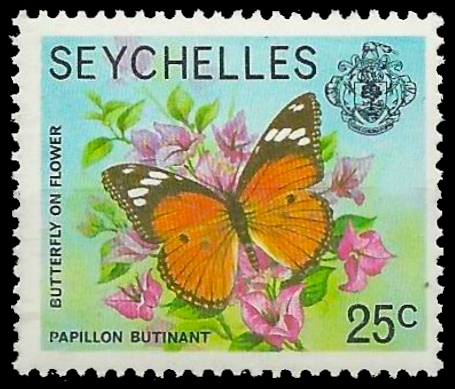
I no longer own a Stanley Gibbons Commonwealth Catalog that covers minor numbers for stamps issued after 1970. That said, several of the Elizabethan Commonwealth Specialized catalogs from the 1970s and 80s listed such stamps. According to Gibbons, there was also a reprint of this stamp dated 1982. Oddly though, the last Elizabethan I have is from 1985 and the 25c dated 1982 is NOT listed despite being listed in 1980.
At least 15 years ago, I emailed Gibbons about this stamp to ask if it actually existed. By that time, I had been searching for at least 10 years, so if you add on the ensuing time I've been looking at least 25 years. The Gibbons catalog department confirmed that (they believe) the 25c dated 1982 exists.
There used to be a stamp dealer in the UK named M&N Haworth, 2 brothers who specialized in all varieties of Elizabethan philately. Their materials were very expensive, but if anyone out there had a scarce Elizabethan stamp in stock, they had it. I believe one of the brothers is deceased, and the second retired several years ago and sold off his stock.
For the time that I was a customer of theirs, the 25c dated 1982 was always listed in their printed catalog as "WANTED." I once asked them about this stamp and was told that they had never actually seen an example, however they persisted in listing it in their retail offerings given that Gibbons had listed it.
About 3 years ago, I saw many these 1977-91 Seychelles date-imprinted definitives being offered on bidStart (HipStamp) by a seller from Australia. She had every other date variety I knew of for sale, but not the 25c/1982. I corresponded with her and found out that she was mainly a collector of Australasia who had begun to build a business selling stamps. She was very familiar with these stamps and was aware that SG had listed the 25c/1982 at various times in the past. She had not ever actually seen an example however, and she assumed it was a catalog error.
So, does this stamp exist? SG insisted it does (at least they did about 15 years ago). Two interested third parties who have actively searched for the stamp had never seen one. And I've never seen one despite searching for it for the past 25 years or so.
Part 2
The second stamp presented in this article is not from the most popular area of philately: Sharjah & Dependencies. But I believe there are quite a few dedicated collectors of Trucial States stamps, especially those stamps listed in the mainstream catalogs. I’ve bid on quite a few Scott- and SG-listed Trucial states stamps over the years and found strong competition on eBay for quality material.
Scott is very limited in their coverage of Sharjah, only listing certain stamps issued between 1963 and 1965. Gibbons however has a much more extensive listing of Sharjah that includes stamps issued up to late 1971. This is not to say that Gibbons gives carte blanche to all Sharjah stamps purported to be postal in nature, as Gibbons provides an appendix with extensive listings of stamps “in excess of postal needs” including all issues labeled with “Khor Fakkan.”
Both Scott and Gibbons agree on a set of nine officials issued by Sharjah in 1965 which were overprinted on stamps from the definitive set of 1963. Scott lists the set as O1 – O10, while Gibbons lists the set as O101 – O109. My 2015 Scott prices the entire set at $14 while my 2009 SG Middle East Catalog prices the set at GBP 13 (approx. $17).
Despite the modest catalog pricing, this set is by no means common. As I write this (Aug 6, 2017), no part of the set is listed anywhere on eBay, Delcampe, HipStamp, or stamps2go save for a group of 8 values with inverted overprints listed for $99 on eBay. Neither Scott nor Gibbons lists the inverted overprints on the 1965 officials stamps.
With this information as a backdrop, I believe there is a hidden gem in this set. Every set I have ever seen offered for sale, except for 1, only offered Scott O2 - O9. The 8 np value, Scott O1 is always missing. Scott value for this single in 2015 was $0.25, and Gibbons in 2009 was 10p.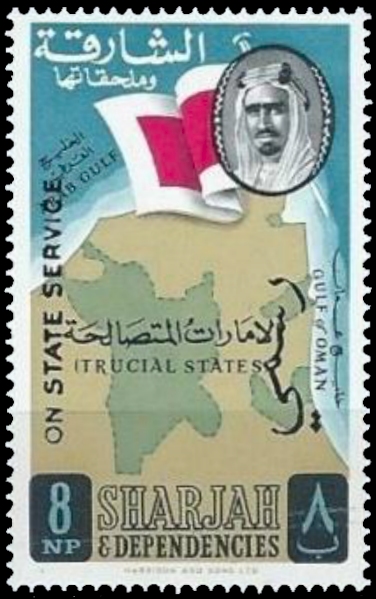
About 12 years ago I did manage to find one set complete MNH, and I bought it from a large seller on eBay for a modest sum. Later, during a period of philatelic boredom I decided to sell off most of my Middle East collection and offered the complete set Buy-It-Now on eBay for $300. It lasted less than 12 hours before being snapped up by a collector in Spain.
Recently, I saw a copy of Scott O1 offered and I managed to buy it for $48, prompting my inclusion of this stamp in this article on undervalued stamps. I don’t know what the true value is of Sharjah Scott O1 however I do know I have only seen 2 copies of this stamp.
Part 3
My third installment in this series centers on a rare and misunderstood stamp from Nigeria. In 1965, Nigeria issued a colorful definitive set depicting wild African animals, Scott 184-97 (Gibbons 172-85). The set has various varieties such as shades, perf changes, and multiple redrawn designs. Scott and Gibbons both list the redrawn stamps as separate sets- Scott 258-67 and Gibbons 220-30 plus 231-2.
Image of the original set from 1965: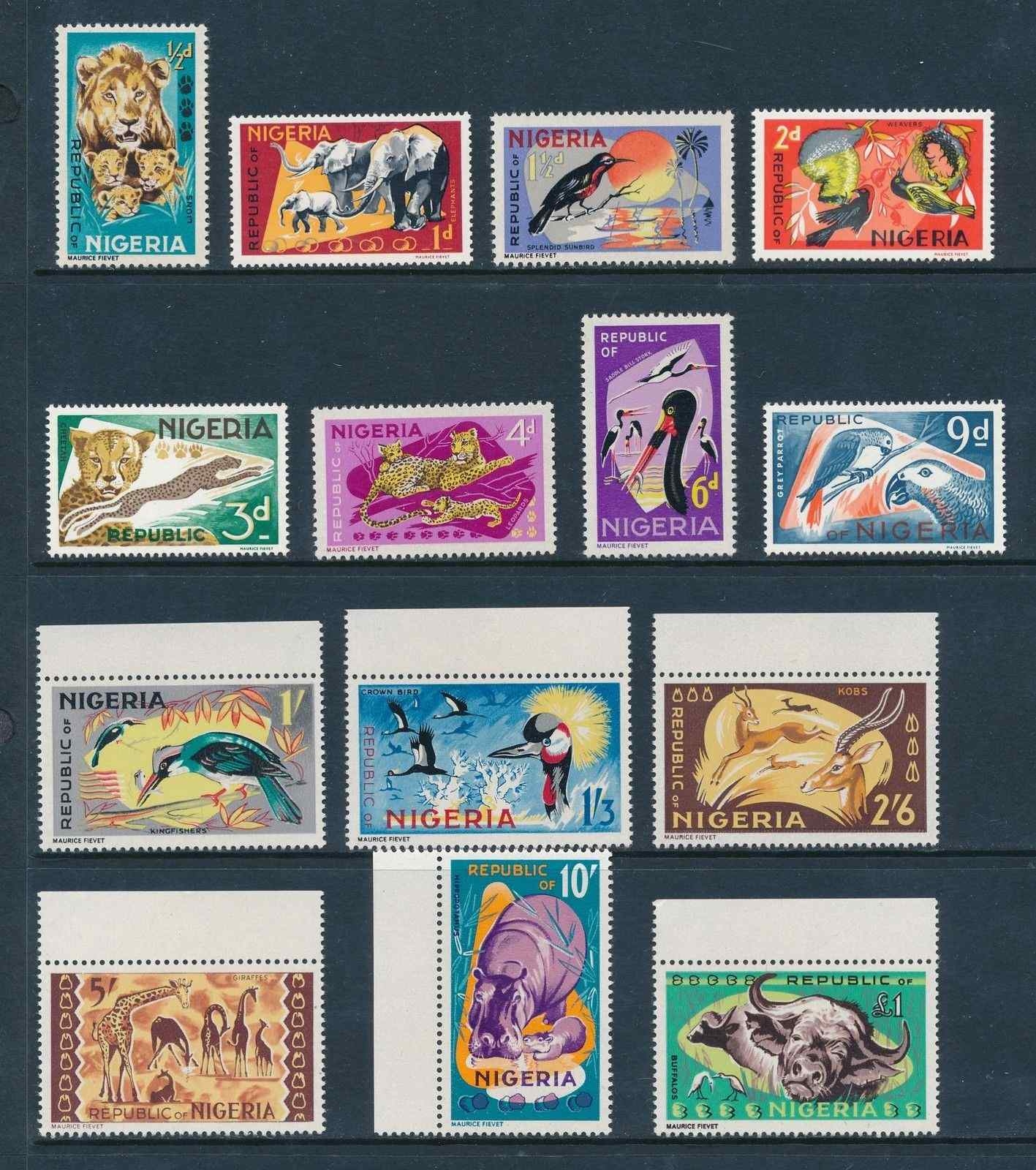
Scott and Gibbons both list a shade variety for the 2d value from this set, the 1971 reprinting with white numeral instead of yellow, 187a and 231 respectively. Gibbons also lists a shade for the 5/- (183a) however those of you who are familiar with this set will know that some values such as the 3d Leopard and 4d Cheetah exist in a broad range of shades.
Our focus now turns to the 4d value which depicts Cheetahs. There are several varieties of this denomination which are easily identified.
Scott 189/Gibbons 177 (Image also applies to Scott 189a which is perf 12.5 x 12):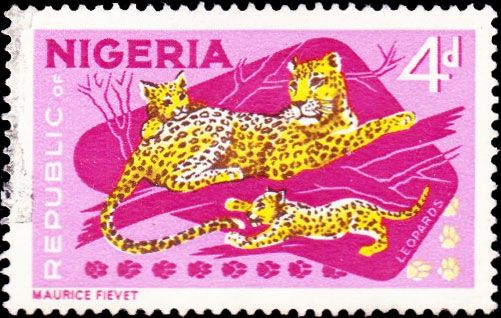
Next is Scott 189b/Gibbons 232 with designer’s imprint at bottom right. Scott notes that the “4” is 5mm wide in this printing, however 189b is easily identified based on the Designer’s imprint now moved to the lower right margin.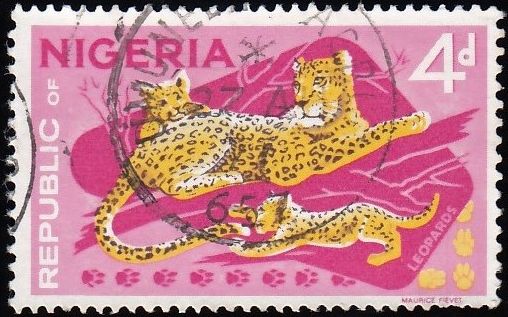
From 1969-72, Nigeria reissued 10 of the original 14 values with redrawn designs and lower-margin imprints. This is the basic 4d stamp one is likely to find from the redrawn set. Note the designer’s name is located at lower right, while the printer’s imprint has been added at lower left: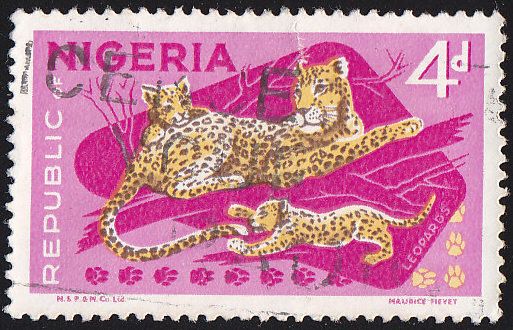
Despite footnoting printing variations for the 2d and 3d for the 1969-72 issues (Scott 259 & 260), Scott does not list any varieties for the 4d stamp, Scott 261. Gibbons lists the redrawn 4d as 224 but lists a variety as well, Gibbons 224a. Gibbons describes 224a simply as “Smaller imprint,” and in the footnotes states:
“No. 224 has the left-hand imprint 6 mm long and the right-hand 5.5 mm. On No. 224a the imprints are 5.5 mm and 4.5 mm respectively. The width of the design is also 0.5 mm smaller.”
Thus, if one is to find SG 224a, one must discern 3 differences in the design that each measure 0.5 to 1 mm. This can’t be done without a glass, and likely can’t be done without measuring. Imagine sitting at a bourse dealer’s table with a known copy of the common printing and sorting through their redrawn 4d’s looking for the scarce variety. Not an ideal situation and frankly, not likely to yield success except with extreme persistence. Why is this the case?
This printing is RARE. Gibbons currently prices 224a MNH at GBP 90, and does not price used at all. That said, I have searched for this variety for years, and have only ever found 3 definite copies, all USED! Two were found in a large accumulation I bought on eBay, however, both copies had significantly damaged perfs due to too-close clipping. The third copy I discovered on Delcampe in 2017, only because I had come up with a way to identify SG 224a without measuring. I have never found a mint copy of this stamp although I very much want one.
How can the rare printing be differentiated without measuring? Below, I present a side-by-side image of Nigeria SG 224 and 224a. Hopefully some differences will jump out at you:
The distinguishing element I use to identify the 2 different imprints is not the font size difference, although the right-hand stamp clearly has a smaller font. Instead, the 3 used copies I have found all have the imprints centered in the middle of the bottom margin, vertically. The common printing has the imprint closely tucked under the paw-prints.
Here is a closer-up comparison. Note the space between the paw prints and the lettering- much wider in the rare printing at left. It is also notable that the “M” in the rare imprint is raised relative to the other letters, and is much shorter in height.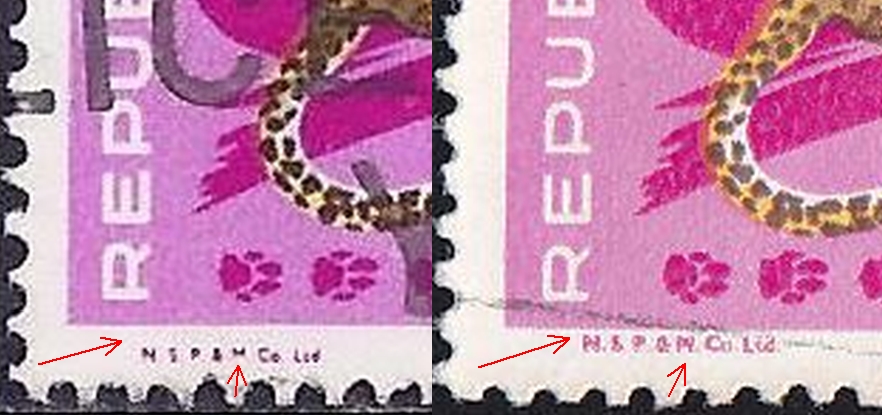
There is obviously a dramatic difference in shades between the stamps, however I don’t have enough info to be sure if this difference is consistent and thus an additional landmark to help separate these 2 printings. Likewise, I cannot say for sure that the rare printing is always centered in the middle of the bottom margin vertically. What I can say for sure is that this stamp is quite rare, especially mint, and that I would like very much to locate a MNH copy.





